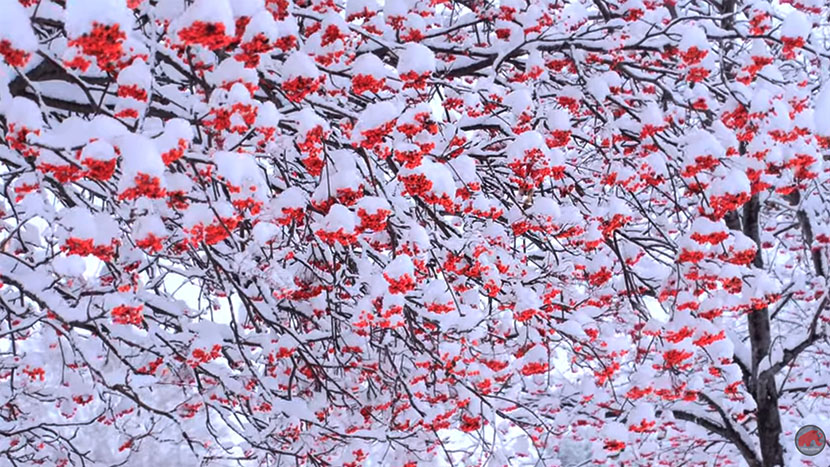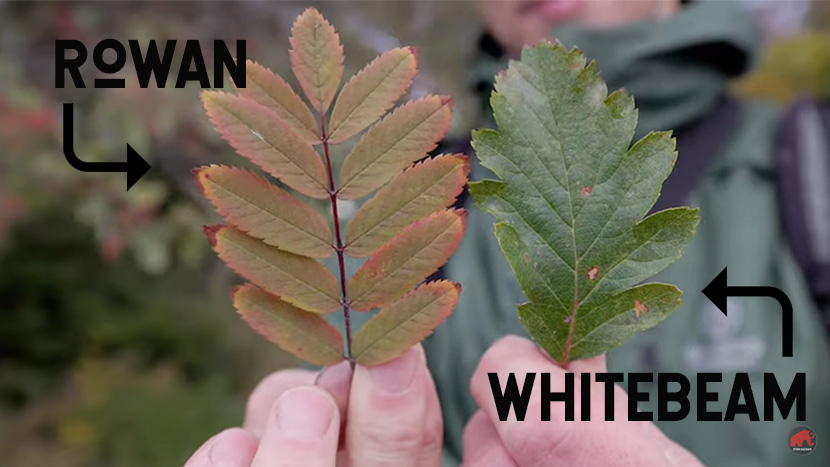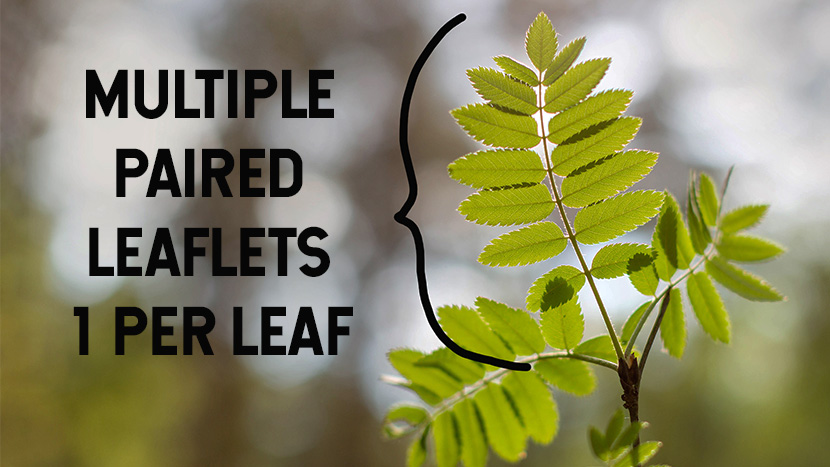The Wonders of The Rowan Tree

On a cold winter’s day, white snow and ice dominate the landscape. Other than a bright-blue sky, it seems as if all color is hibernating along with the small critters of the forest. Until, from the corner of your eye, you spot a tree full of impossibly red berries. A Rowan tree! A tree of legend, a tree that has fallen victim to modern misunderstanding, and, a tree that we think, is something you should know more about!
All About Rowan Trees
The Rowan tree, which is also referred to as Mountain Ash, is a deciduous tree in the Rosaceae family (yep the rose family!). It is found in northern climates throughout North America, Europe, and Asia.
Rowan trees are a key part of the ecosystem as they provide a vital food source for birds, especially after the first frosts of winter. The trees are also considered sacred and their berries have been a part of northern diets for a long time, but you have to know a little trick about them first.
The Taxonomy of The “Rowan Tree”
In general, Rowan trees/Mountain Ash consist of tree species in the Genus Sorbus, with quite a few different species depending where you are. In fact, there are around 100 species of tree in the Sorbus genus. So, the next time that you are out looking for Rowan trees, you might have to find a local guide for more specific identification.
Some examples of Sorbus trees (listed with one of their common names) are:
- Sorbus aucuparia – European Mountain Ash/Rowan
- Sorbus reducta – Dwarf Chinese mountain ash
- Sorbus commixta – Japanese Rowan
- Sorbus sargentiana – Sargent’s Rowan
- Sorbus domestica – The Service Tree
- Sorbus torminalis – The Wild service tree
- Sorbus aria – Common Whitebeam
- Sorbus intermedia – Swedish Whitebeam

General Identification of Rowan Trees
There are a lot of different Sorbus trees out there, but Rowan trees can generally be identified as follows:
Rowan trees can range around 15ft (4.5m) to somewhere around 40ft (12m), depending on the species. The bark is light to dark grey and is smooth on young trees but becomes scaly as it ages.
Rowan trees are easiest to find while they are sporting their bright-red, or orangish, round berries. Otherwise the flowers are found in clusters of around 4 inches (10 cm), are creamy-white, and have five petals.
The berries from a Rowan Tree look a bit like Lingonberries (Vaccinium vitis-idaea), which on the other hand come from small evergreen shrubs in the heath family. So, even though the berries look alike, you probably won’t mix up the entire plant. Also, lingonberries have a tart and sweet taste, more like a cranberry.
If you taste the berries from a Rowan tree before the first big frost, you will notice that they are extremely bitter. Really they seem like something you should not be eating, which is partly true – at least until later in the year or after preparation. More on that below!
True Rowan trees have leaves with one long petiole with multiple serrated and paired leaflets. Meaning you can see that each leaflet (except for the last one) has a partner directly opposite to it. You can compare this to the leaf of a Whitebeam for example, which is one solid leaflet.

Sometimes you might get really lucky and find what is called a “Flying Rowan tree.” This happens when a sapling has managed to grow out of another tree, essentially becoming an epiphyte – a plant that grows on other plants. This is a really interesting phenomenon and historically these Flying Rowans were said to be extra special in terms of their ability to protect against dark magic.
Can you eat Rowan Tree Berries?
Now, many of you have probably had doubts about eating mountain ash berries, and that is probably because you were told that they are toxic and inedible. And even though it seems odd at first, they are toxic during most of their lifespan, the second part is untrue.
You see, Rowan Tree berries contain an acid called parasorbic acid, which in the best case can cause indigestion, and worst case can cause kidney and liver damage, but there is a way that this parasorbic acid turns into an entirely harmless sorbic acid!
If you cook or freeze them that parasorbic acid gets turned into sorbic acid, which is harmless. This process also makes them sweeter and palatable. Then you are able to receive some of the many health benefits of this awesome little berry!
There is also cyanogenic glycoside prunasin in these berries, which is another potentially harmful compound when eaten in large quantities, but cooking neutralizes the compound, and though freezing should also help, you can ditch the seeds if you want to be extra safe.
Traditionally, many people simply harvest them after the first frost, which is when you will mostly see the birds eating them anyways, or they prepare them by freezing or heating, especially to make a classic bitter jelly that is often served alongside wild meats. There are also people who make liqueurs and schnapps that are said to be quite delicious!
So, long story short, eating Rowan tree berries is totally okay, as long as you freeze or heat them first!
How Does Parasorbic Acid Become Sorbic Acid?
In case you are curious, how does this “magical” change happen so that we are able to eat this berry? Well, in a short and sweet sense, parasorbic acid is a chemical compound that forms a ring, and when it gets heated or frozen, compounds on the ring are catalyzed and react in such a way (with water and other acids) that the ring is opened. This acid now has a new chemical structure, that of sorbic acid! This small reaction turns something harmful into something that is harmless. It also gives it some really useful properties – like the antimicrobial properties that make it great for food preservation. In fact, sorbic acid was isolated from the Sorbus genus as a food preservative as early as 1859! The other compounds found in Rowan berries are also really beneficial for general health, and as traditional medicine.

Medicinal Uses of Rowanberries
Once frozen or heated, Mountain Ash berries are on par, if not better for you than rose hips! Rowan berries are a great source of vitamin C (ascorbic acid) and have anti-inflammatory, antidiarrheal, and diuretic properties. These berries have also been used traditionally to treat many ailments, such as it use for:
- Treating intestinal blockages
- Treating liver and gallbladder problems
- To help with appetite
- Treat a sore throat, colds, and fevers
- As a laxative
- Reduce arthritis, muscle, and joint pain
- And more…
Though this seems like a lot, there are many beneficial compounds found in this small yet powerful berry. Other than plentiful vitamins and key minerals, such as iron, zinc, and magnesium, these berries also have carotenoids and a long list of phenolic acids. These acids have anti-inflammatory, antimicrobial (remember sorbic acid as a preservative!), anti-osteoarthritis, and even anticancer effects for people!
Other Uses of The Rowan Tree
Rowan tree wood is also used in building and woodworking, being particularly useful for longbows and knife handles. This tree is often planted as an ornamental tree that can also be beneficial to wildlife and people.
Throughout history Rowan Trees have also been planted or cared for due their cultural significance.
Myths and Folklore About The Rowan Tree
A few different cultures, the Celtics and Norse for example, hold reverence for Rowan trees due to their ability to ward off all things evil. Neo Druidism also considered it a portal tree between this world and the next.
There is also a very interesting Norse legend involving Thor, hence the Rowan tree’s nickname “The Salvation of Thor.” In short, Thor was able to pull himself out of a dangerous situation using a rowan tree branch. Watch the video above to hear Jonas read us the tale!
In conclusion, The Rowan Tree is a beautiful tree with both ecological and cultural significance in northern landscapes. Despite some misconceptions, this tree’s sometimes-toxic berries can be enjoyed after winter’s first frost, or when prepared with a little bit of heat!

